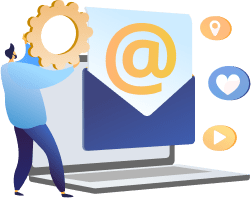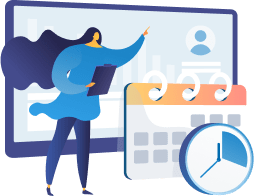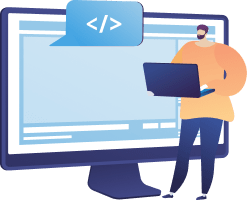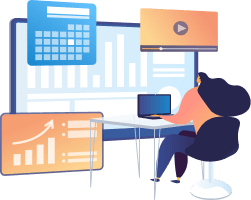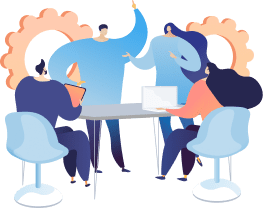Our Approach to the Engagement Process
Regardless of the engagement model our clients choose, we at SCAND are glad to help with any software development initiative. Our software development team owns all core competencies to deliver a project on time and within budget. Our extensive expertise in a wide array of technologies allows us to select the right tools, frameworks, and programming languages for product development without being limited to one or two options. We treat our clients as partners and always go the extra mile to build a turnkey solution and exceed project expectations.
There are many factors to consider when choosing a software outsourcing model, several factors in particular stand out:
- The level of flexibility you require.
- How much in-house expertise you have available.
- Your primary business objective.
- How much control you want to retain.
- How much time you have to devote to the outsourcing relationship.
Engagement Models We Offer
Every model has its own advantages and disadvantages and is effective only in certain scenarios. However, the most popular engagement models in IT industry are: Time and Materials Contract, Fixed Bid, Outstaffing, Dedicated Team. Before choosing any of the engagement models we recommend you to consider the specifics of your project and your business requirements. If you’re hesitating you can get a consultation from our specialists - they will provide help you select the most cost-efficient model.
Fixed Bid
- Working efficiently on the projects with clear, stable, and settled requirements;
- The cost to build an app is fixed and discussed before the fulfillment of the project;
- Only pre-discussed ‘milestones’ of the project are charged, we expect the payment once it is finished.
When to Use?
Ideal for small-size or urgent projects. Fixed bid perfectly works when the project specifications are clearly defined and unlikely to change.
Time and Materials Contract (T&M)
- Ideal for the projects that are expected to change or don’t have clear requirements;
- The cost of software development is based on direct labor hours at a pre-discussed hour rate;
- Working efficiently when the client requires some parts of the project off-loaded in time.
When to Use?
In a T&M contract, the customer should be able to estimate the hours needed for a job and negotiate lower hourly rates to reduce the total software development cost.
- It perfectly works for sophisticated, long-lasting projects;
- Full control over the development process;
- Significant cost-savings on infrastructure, social benefits, etc.;
- Fast and simple access to the skills your project needs.
When to Use?
This software development model implies hiring specialists with certain skills and experience in order to temporarily extend your existing in-house team while the additional workforce is required.
Dedicated Team (ODT)
- Perfect for all types of projects;
- The team is 100% dedicated and managed by the customer;
- No hiring efforts, ability to quickly scale the team.
All Contract Types Include
When it comes to contracts, the best thing is to contact us and get advice from our consultants. They will analyze your requirements and constraints and create a contract perfectly aligned to your project.
Strong non-disclosure obligations
Statement of Work
Management and reporting terms
Maintenance and support conditions
Full transfer of intellectual property rights on the code and documentation that we will develop for you
Payment terms depending on the contract type as the rates on software development might vary
Other general conditions typical for master service agreements
Workflow
After choosing a type of software development contract, it is time to decide on the most suitable type of workflow. SCAND engineers are skilled at implementing any kind of workflow requested by the customer. We could split traditional frameworks and use the hybrid approach, taking the best suitable elements from Agile, Scrum, Kanban, and ‘old faithful’ Waterfall.
Agile
Agile development methods are more efficient when the final goal of the project is not defined and the customer wants the development team to react to the changed requirements rapidly and effectively.
- Emphasis on the experimental software development and flexible design pattern
- Oriented on the teamwork environment and collaboration
- Stands for evolutionary development and adaptive
Waterfall
Waterfall software development is ideal for static projects when the customer’s requirements are set and the changes are not likely to happen through the development process.
- Works well for small scope projects where requirements are clearly defined
- Reliable budget and time estimation
- No overlapping as all the tasks are sequential
Scrum
To manage the development of complex software in fixed-length iterations, the Scrum approach could be the best matching. The development process is divided into sprints, and the team interacts with the customer once the sprint is completed.
- Ideal for the swing project development
- Testing is performed throughout the development
- Changes are anticipated along the way
Kanban
This approach is based on Agile but involves a bigger visual component. The benefit of Kanban is that it gives businesses an opportunity to be reactive towards customers’ demands instead of trying to predict the needs.
- Increased flexibility
- The visual component makes it easy to learn
- Optimized workflow
Communication
Finding the best communication channels with our customers is our top priority, especially when it comes to software development outsourcing. A well-organized interaction is a basis for any outsourcing software development company. We are ready to use the following channels:
How to Start
At SCAND we implement an individual approach to each customer as the project scope and requirements may vary. Some clients turn to us with a brief project description, while others – with comprehensive information on the project (documentation, design, mockups, wireframes). No matter what requirements you have, we are always ready to help you. Learn how to start working with us:
1. You Ask
Share your ideas and expectations with us, specify the project requirements or send an RFP, RPI, RFQ. We are always ready to sign your non-disclosure agreement or can provide you with ours.
2. We Proceed
Our engineering team has a deep overview of the customer requirements to come up with the best UI/UX, architecture and technology stack alternatives.
3. Negotiate
We discuss with client project requirements and clarify the details, outline the project roadmap and conduct interviews with software engineers if needed.
4. You get
Commercial project estimation in terms of time and cost, suggestions on architecture, technology platforms, tools, and methodologies.
FAQ
There are many engagement models to consider when start working with a software development provider, learn some facts and tips that might help you to choose the right model for cooperation:
